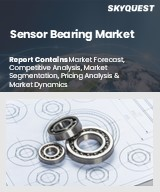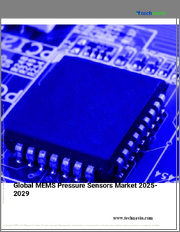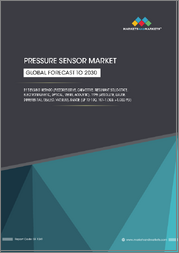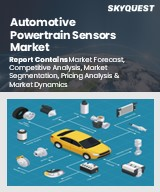
|
시장보고서
상품코드
1503442
압력 센서 시장 예측(-2030년) : 제품별, 기술별, 접속성별, 압력 범위별, 최종사용자별, 지역별 세계 분석Pressure Sensor Market Forecasts to 2030 - Global Analysis By Product, Technology, Connectivity, Pressure Range, End User and By Geography |
||||||
Stratistics MRC에 따르면 세계의 압력 센서 시장은 2024년에 214억 4,000만 달러를 차지하고 예측 기간 중 CAGR은 6.4%로 성장하며, 2030년에는 311억 1,000만 달러에 달할 것으로 예측되고 있습니다.
압력 센서는 유체(액체 또는 기체)가 표면에 가하는 힘을 측정합니다. 이 힘을 전기 신호로 변환하여 다른 장비나 시스템에서 쉽게 해석할 수 있도록 합니다. 이 센서는 절대 압력(진공에 대한 상대적 압력), 게이지 압력(대기압에 대한 상대적 압력) 또는 차압(두 지점 사이의 차압)을 감지할 수 있습니다.
미국 고속도로교통안전국(NHTSA)에 따르면 에어백은 미국에서 5만 명 이상의 생명을 구했습니다.
자동차 산업
자동차 산업은 다양한 용도에서 압력 센서를 광범위하게 사용하기 때문에 압력 센서 시장의 주요 촉진제 역할을 하고 있습니다. 압력 센서는 타이어 압력, 엔진 연소, 제동 시스템, 에어백 도입 등을 모니터링하여 자동차의 안전, 효율성 및 성능을 보장하는 데 중요한 역할을 합니다. 자동차 제조업체들이 연비를 개선하고 배기가스 배출을 줄이기 위해 노력하면서 보다 정확하고 신뢰할 수 있는 압력 센서에 대한 수요는 계속 증가하고 있습니다. 또한 전기자동차(EV)와 자율주행차(AV)의 등장은 압력 센서에 대한 수요를 더욱 촉진하고 있습니다. 이러한 자동차는 최적의 운전을 위해 정확한 압력 모니터링에 크게 의존하고 있기 때문입니다.
신뢰성과 내구성
압력 센서 시장의 신뢰성과 내구성을 저해하는 요인은 종종 압력 센서가 배치되는 열악한 작동 환경에서 기인합니다. 압력 센서는 특히 극한의 온도, 고압, 부식성 대기와 같은 가혹한 조건에서 장기간 일관된 정확도를 유지해야 하는 과제에 직면해 있습니다. 장기적인 안정성과 신뢰성을 보장하기 위해서는 견고한 설계와 재료가 필요하며, 이는 제조 비용을 증가시킵니다. 또한 기계적 스트레스, 진동, 전기적 간섭과 같은 요인이 센서의 성능에 영향을 미칠 수 있으므로 엄격한 테스트 및 품질관리 조치가 필요합니다.
IoT(사물인터넷) 용도
IoT내 압력 센서 시장은 다양한 부문에 걸쳐 방대한 기회를 제공합니다. 산업 환경에서는 IoT 지원 압력 센서가 장비의 성능을 모니터링하고 최적화하여 적시에 유지보수를 보장하고 고장을 방지하여 효율성을 높입니다. 헬스케어 분야에서는 이러한 센서를 통해 환자를 원격으로 모니터링하고 혈압 관리와 같은 중요한 상태에 대한 정확한 데이터 수집을 보장할 수 있습니다. 농업 분야에서는 IoT 압력 센서가 토양 수분 및 작물 압력 데이터를 실시간으로 제공하여 관개 및 자원 활용을 최적화하는 데 도움이 될 수 있습니다. 스마트홈 용도는 보안 시스템에 압력 센서를 활용하여 무단 침입이나 기압 변화를 감지할 수 있습니다.
대체 기술
압력 센서 시장은 광학, 음향, 정전식 센서와 같은 대체 센싱 기법에 의한 대체 기술의 위협에 직면해 있습니다. 이러한 대체 기술은 서로 다른 측정 원리를 제공하며, 더 높은 정확도, 더 빠른 응답 시간, 특정 용도에 대한 더 나은 적합성 등의 이점을 제공할 수 있습니다. 예를 들어 광학 센서는 비접촉식 측정이 가능하며, 음향 센서는 열악한 환경에서 더 나은 성능을 발휘할 수 있습니다. 이러한 대체 기술이 계속 발전함에 따라 기존 압력 센서에 대한 도전이 계속되고 있습니다.
COVID-19의 영향 :
COVID-19는 몇 가지 측면에서 압력 센서 시장에 큰 영향을 미쳤습니다. 첫째, 세계 공급망의 혼란으로 인해 원자재와 부품이 부족하여 생산 지연과 가격 변동이 발생했습니다. 또한 봉쇄 조치와 경제 불확실성으로 인해 압력 센서의 주요 사용자 인 자동차, 제조, 항공우주 및 기타 산업 수요가 감소했습니다. 그러나 의료 분야에서는 인공호흡기 및 모니터링 장비를 포함한 의료 장비에 대한 수요가 급증하여 압력 센서의 판매가 일시적으로 증가했습니다.
예측 기간 중 게이지 압력 센서 부문이 가장 큰 비중을 차지할 것으로 예상됩니다.
게이지 압력 센서 부문은 몇 가지 요인으로 인해 압력 센서 시장에서 큰 성장세를 보이고 있습니다. 우선, 자동차, 항공우주, 제조 등의 산업에서 공정의 정확한 모니터링 및 제어를 위해 압력 센서를 시스템에 통합하는 사례가 증가하고 있습니다. 또한 기술 발전으로 인해 보다 정확하고 신뢰할 수 있는 게이지 압력 센서가 개발되어 수요가 증가하고 있습니다. 또한 다양한 용도에서 효율성과 안전에 대한 관심이 높아지면서 압력 센서의 채택이 증가하고 있으며, 이는 이 부문의 성장을 더욱 촉진하고 있습니다.
항공 분야는 예측 기간 중 가장 높은 CAGR을 나타낼 것으로 예상됩니다.
압력 센서 시장의 항공 분야는 몇 가지 요인으로 인해 강력한 성장을 보이고 있습니다. 항공기 기술의 발전으로 인해 안전과 성능을 보장하기 위해 보다 정밀하고 신뢰할 수 있는 압력 센서가 요구되고 있습니다. 또한 경제 성장과 세계화에 따른 항공 여행 수요 증가는 첨단 센서 시스템을 갖춘 더 많은 항공기에 대한 수요를 촉진하고 있습니다. 또한 항공기 안전 및 연료 효율에 대한 엄격한 규제로 인해 최첨단 압력 감지 기술의 채택이 요구되고 있습니다.
최대 점유율 지역 :
북미 압력 센서 시장의 성장은 여러 가지 요인에 기인합니다. 자동차, 헬스케어, 제조업 등 다양한 산업 분야 수요 증가가 시장 확대의 원동력이 되고 있습니다. 또한 MEMS 기반 센서와 같은 압력 감지 기술의 기술적 진보가 시장 성장을 가속하고 있습니다. 또한 자동차와 같은 안전 및 배기가스 규제에 대한 엄격한 규제 요건도 압력 센서의 채택을 촉진하고 있습니다.
CAGR이 가장 높은 지역 :
아시아태평양은 몇 가지 중요한 요인으로 인해 압력 센서 시장에서 큰 성장세를 보이고 있습니다. 중국, 인도, 한국과 같은 국가의 급속한 산업화로 인해 제조 및 자동화 공정에서 압력 센서에 대한 수요가 증가했습니다. 또한 이 지역의 자동차 및 가전 산업의 확장은 타이어 압력 모니터링 및 터치 감지 인터페이스와 같은 용도에서 압력 센서의 필요성을 촉진하고 있습니다. 스마트 시티 및 인프라 프로젝트의 출현은 다양한 모니터링 및 제어 시스템에서 압력 센서에 대한 수요를 더욱 증가시키고 있습니다.
무료 맞춤형 서비스 :
이 보고서를 구독하는 고객은 다음과 같은 무료 맞춤화 옵션 중 하나를 사용할 수 있습니다.
- 기업 개요
- 추가 시장 기업의 종합적인 프로파일링(최대 3사)
- 주요 기업의 SWOT 분석(최대 3사)
- 지역 세분화
- 고객의 관심에 따른 주요 국가별 시장 추정치, 예측, CAGR(주: 타당성 확인에 따라 다름)
- 경쟁사 벤치마킹
- 제품 포트폴리오, 지역적 입지, 전략적 제휴를 기반으로 한 주요 기업 벤치마킹
목차
제1장 주요 요약
제2장 서문
- 개요
- 이해관계자
- 조사 범위
- 조사 방법
- 데이터 마이닝
- 데이터 분석
- 데이터 검증
- 조사 어프로치
- 조사 정보원
- 1차 조사 정보원
- 2차 조사 정보원
- 전제조건
제3장 시장 동향 분석
- 촉진요인
- 억제요인
- 기회
- 위협
- 제품 분석
- 기술 분석
- 최종사용자 분석
- 신흥 시장
- COVID-19의 영향
제4장 Porter's Five Forces 분석
- 공급 기업의 교섭력
- 구매자의 교섭력
- 대체품의 위협
- 신규 진출업체의 위협
- 경쟁 기업간 경쟁 관계
제5장 세계의 압력 센서 시장 : 제품별
- 절대 압력 센서
- 차압 센서
- 게이지 압력 센서
- 밀폐형 압력 센서
- 진공 압력 센서
제6장 세계의 압력 센서 시장 : 기술별
- 공진 고체
- 압전 저항형
- 광학
- 전자
- 정전용량식
- 기타 센싱 방법
제7장 세계의 압력 센서 시장 : 접속성별
- 무선 센서
- 유선 센서
제8장 세계의 압력 센서 시장 : 압력 범위별
- 100psi 미만
- 101-1,000psi
- 1,000psi 이상
제9장 세계의 압력 센서 시장 : 최종사용자별
- 유틸리티
- 석유 및 가스
- 의료
- 해양
- 제조업
- 소비자용 디바이스
- 항공
- 자동차
- 기타 용도
제10장 세계의 압력 센서 시장 : 지역별
- 북미
- 미국
- 캐나다
- 멕시코
- 유럽
- 독일
- 영국
- 이탈리아
- 프랑스
- 스페인
- 기타 유럽
- 아시아태평양
- 일본
- 중국
- 인도
- 호주
- 뉴질랜드
- 한국
- 기타 아시아태평양
- 남미
- 아르헨티나
- 브라질
- 칠레
- 기타 남미
- 중동 및 아프리카
- 사우디아라비아
- 아랍에미리트
- 카타르
- 남아프리카공화국
- 기타 중동 및 아프리카
제11장 주요 발전
- 계약, 파트너십, 협업, 합병사업
- 인수합병
- 신제품 발매
- 사업 확대
- 기타 주요 전략
제12장 기업 프로파일링
- ABB Ltd.
- AlphaSense
- Analog Devices, Inc.
- Aptiv
- Bosch GmbH
- City Technology Ltd.
- Continental
- Denso Corporation
- Dynament Ltd.
- Emerson Electric Co.
- Figaro Engineering Inc.
- Honeywell International Inc.
- Infineon Technologies
- NXP Semiconductors
- Sensata Technologies
- Siemens AG
- Te Connectivity
According to Stratistics MRC, the Global Pressure Sensor Market is accounted for $21.44 billion in 2024 and is expected to reach $31.11 billion by 2030 growing at a CAGR of 6.4% during the forecast period. A pressure sensor measures the force exerted by a fluid (liquid or gas) on a surface. It converts this force into an electrical signal that can be easily interpreted by other devices or systems. These sensors can detect absolute pressure (relative to a vacuum), gauge pressure (relative to atmospheric pressure), or differential pressure (between two points).
According to the National Highway Traffic Safety Administration (NHTSA), airbags have saved over 50,000 lives in the United States.
Market Dynamics:
Driver:
Automotive industry
The automotive industry is a key driver of the pressure sensor market due to its extensive use of pressure sensors in various applications. Pressure sensors play a crucial role in ensuring vehicle safety, efficiency, and performance by monitoring tire pressure, engine combustion, brake systems, and airbag deployment. As automotive manufacturers strive for advancements in fuel efficiency and emissions reduction, the demand for more accurate and reliable pressure sensors continues to grow. Additionally, the rise of electric vehicles (EVs) and autonomous vehicles (AVs) further fuels the demand for pressure sensors, as these vehicles rely heavily on precise pressure monitoring for optimal operation.
Restraint:
Reliability and durability
The reliability and durability restraints in the pressure sensor market often stem from the demanding operational environments they're deployed in. Pressure sensors face challenges in maintaining consistent accuracy over time, particularly in harsh conditions like extreme temperatures, high pressure, or corrosive atmospheres. Ensuring long-term stability and reliability requires robust design and materials, increasing manufacturing costs. Additionally, factors like mechanical stress, vibration, and electrical interference can impact sensor performance, necessitating rigorous testing and quality control measures.
Opportunity:
IoT (Internet of Things) applications
The pressure sensor market within IoT presents vast opportunities across various sectors. In industrial settings, IoT-enabled pressure sensors enhance efficiency by monitoring and optimizing equipment performance, ensuring timely maintenance, and preventing breakdowns. In healthcare, these sensors enable remote patient monitoring, ensuring accurate data collection for critical conditions like blood pressure management. Agriculture benefits from IoT pressure sensors by providing real-time soil moisture and crop pressure data and optimizing irrigation and resource usage. Smart home applications leverage pressure sensors for security systems, detecting unauthorized entries or changes in air pressure.
Threat:
Substitute technologies
The pressure sensor market faces a substitute technology threat from alternative sensing methods like optical, acoustic, or capacitive sensors. These substitutes offer different measurement principles and may provide advantages such as higher accuracy, faster response times, or better suitability for specific applications. For instance, optical sensors can offer non-contact measurement, while acoustic sensors may excel in harsh environments. As these substitute technologies continue to advance, they pose a challenge to traditional pressure sensors.
Covid-19 Impact:
The COVID-19 pandemic significantly impacted the pressure sensor market in several ways. Initially, disruptions in the global supply chain led to shortages of raw materials and components, causing production delays and price fluctuations. Additionally, lockdown measures and economic uncertainty led to decreased demand from industries such as automotive, manufacturing, and aerospace, which are key users of pressure sensors. However, the healthcare sector witnessed a surge in demand for medical devices, including ventilators and monitoring equipment, driving a temporary uptick in pressure sensor sales.
The gauge pressure sensors segment is expected to be the largest during the forecast period
The gauge pressure sensor segment is experiencing significant growth within the pressure sensor market due to several factors. Firstly, industries such as automotive, aerospace, and manufacturing are increasingly integrating pressure sensors into their systems for precise monitoring and control of processes. Additionally, advancements in technology have led to the development of more accurate and reliable gauge pressure sensors, driving up their demand. Moreover, the growing emphasis on efficiency and safety in various applications is fueling the adoption of pressure sensors, further boosting the growth of this segment.
The aviation segment is expected to have the highest CAGR during the forecast period
The aviation segment within the pressure sensor market is experiencing robust growth due to several factors. Advancements in aircraft technology require more precise and reliable pressure sensors to ensure safety and performance. Additionally, the increasing demand for air travel, driven by economic growth and globalization, fuels the need for more aircraft equipped with advanced sensor systems. Furthermore, stringent regulations regarding aircraft safety and fuel efficiency necessitate the adoption of state-of-the-art pressure sensing technologies.
Region with largest share:
The growth of the pressure sensor market in North America can be attributed to several factors. Increasing demand across various industries such as automotive, healthcare, and manufacturing is driving market expansion. Additionally, technological advancements in pressure sensing technologies, such as MEMS-based sensors, are fostering market growth. Moreover, stringent regulatory requirements in industries like automotive for safety and emission controls are boosting the adoption of pressure sensors.
Region with highest CAGR:
The Asia-Pacific region has experienced significant growth in the pressure sensor market due to several key factors. Rapid industrialization across countries like China, India, and South Korea has led to increased demand for pressure sensors in manufacturing and automation processes. Additionally, the expansion of the automotive and consumer electronics industries in the region has fuelled the need for pressure sensors in applications like tire pressure monitoring and touch-sensitive interfaces. The emergence of smart cities and infrastructure projects has further driven demand for pressure sensors in various monitoring and control systems.
Key players in the market
Some of the key players in Pressure Sensor market include ABB Ltd., AlphaSense, Analog Devices, Inc., Aptiv, Bosch GmbH, City Technology Ltd., Continental, Denso Corporation, Dynament Ltd., Emerson Electric Co., Figaro Engineering Inc., Honeywell International Inc., Infineon Technologies, NXP Semiconductors, Sensata Technologies, Siemens AG and Te Connectivity.
Key Developments:
In June 2024, Emerson announced that it has entered into a definitive agreement to sell its remaining interests in the Copeland joint venture (formerly Emerson Climate Technologies) for a transaction value of approximately $3.5 billion, with pre-tax cash proceeds of $3.4 billion, net of the release of $0.1 billion of future indemnity obligations.
In June 2024, Siemens Smart Infrastructure and BASF have announced the first electrical safety product to include components made from biomass-balanced plastics. Used across industrial and infrastructure applications, Siemens SIRIUS 3RV2 circuit breaker is now being manufactured using Ultramid(R) BMBcertTM and Ultradur(R) BMBcertTM from BASF.
Products Covered:
- Absolute Pressure Sensors
- Differential Pressure Sensors
- Gauge Pressure Sensors
- Sealed Pressure Sensors
- Vacuum Pressure Sensors
Technologies Covered:
- Resonant Solid-state
- Piezoresistive
- Optical
- Electromagnetic
- Capacitive
- Other Sensing Methods
Connectivities Covered:
- Wireless Sensors
- Wired Sensors
Pressure Ranges Covered:
- Up to 100 psi
- 101 to 1,000 psi
- Above 1,000 psi
End Users Covered:
- Utilities
- Oil & Gas
- Medical
- Marine
- Manufacturing
- Consumer Devices
- Aviation
- Automotive
- Other End Uses
Regions Covered:
- North America
- US
- Canada
- Mexico
- Europe
- Germany
- UK
- Italy
- France
- Spain
- Rest of Europe
- Asia Pacific
- Japan
- China
- India
- Australia
- New Zealand
- South Korea
- Rest of Asia Pacific
- South America
- Argentina
- Brazil
- Chile
- Rest of South America
- Middle East & Africa
- Saudi Arabia
- UAE
- Qatar
- South Africa
- Rest of Middle East & Africa
What our report offers:
- Market share assessments for the regional and country-level segments
- Strategic recommendations for the new entrants
- Covers Market data for the years 2022, 2023, 2024, 2026, and 2030
- Market Trends (Drivers, Constraints, Opportunities, Threats, Challenges, Investment Opportunities, and recommendations)
- Strategic recommendations in key business segments based on the market estimations
- Competitive landscaping mapping the key common trends
- Company profiling with detailed strategies, financials, and recent developments
- Supply chain trends mapping the latest technological advancements
Free Customization Offerings:
All the customers of this report will be entitled to receive one of the following free customization options:
- Company Profiling
- Comprehensive profiling of additional market players (up to 3)
- SWOT Analysis of key players (up to 3)
- Regional Segmentation
- Market estimations, Forecasts and CAGR of any prominent country as per the client's interest (Note: Depends on feasibility check)
- Competitive Benchmarking
- Benchmarking of key players based on product portfolio, geographical presence, and strategic alliances
Table of Contents
1 Executive Summary
2 Preface
- 2.1 Abstract
- 2.2 Stake Holders
- 2.3 Research Scope
- 2.4 Research Methodology
- 2.4.1 Data Mining
- 2.4.2 Data Analysis
- 2.4.3 Data Validation
- 2.4.4 Research Approach
- 2.5 Research Sources
- 2.5.1 Primary Research Sources
- 2.5.2 Secondary Research Sources
- 2.5.3 Assumptions
3 Market Trend Analysis
- 3.1 Introduction
- 3.2 Drivers
- 3.3 Restraints
- 3.4 Opportunities
- 3.5 Threats
- 3.6 Product Analysis
- 3.7 Technology Analysis
- 3.8 End User Analysis
- 3.9 Emerging Markets
- 3.10 Impact of Covid-19
4 Porters Five Force Analysis
- 4.1 Bargaining power of suppliers
- 4.2 Bargaining power of buyers
- 4.3 Threat of substitutes
- 4.4 Threat of new entrants
- 4.5 Competitive rivalry
5 Global Pressure Sensor Market, By Product
- 5.1 Introduction
- 5.2 Absolute Pressure Sensors
- 5.3 Differential Pressure Sensors
- 5.4 Gauge Pressure Sensors
- 5.5 Sealed Pressure Sensors
- 5.6 Vacuum Pressure Sensors
6 Global Pressure Sensor Market, By Technology
- 6.1 Introduction
- 6.2 Resonant Solid-state
- 6.3 Piezoresistive
- 6.4 Optical
- 6.5 Electromagnetic
- 6.6 Capacitive
- 6.7 Other Sensing Methods
7 Global Pressure Sensor Market, By Connectivity
- 7.1 Introduction
- 7.2 Wireless Sensors
- 7.3 Wired Sensors
8 Global Pressure Sensor Market, By Pressure Range
- 8.1 Introduction
- 8.2 Up to 100 psi
- 8.3 101 to 1,000 psi
- 8.4 Above 1,000 psi
9 Global Pressure Sensor Market, By End User
- 9.1 Introduction
- 9.2 Utilities
- 9.3 Oil & Gas
- 9.4 Medical
- 9.5 Marine
- 9.6 Manufacturing
- 9.7 Consumer Devices
- 9.8 Aviation
- 9.9 Automotive
- 9.10 Other End Uses
10 Global Pressure Sensor Market, By Geography
- 10.1 Introduction
- 10.2 North America
- 10.2.1 US
- 10.2.2 Canada
- 10.2.3 Mexico
- 10.3 Europe
- 10.3.1 Germany
- 10.3.2 UK
- 10.3.3 Italy
- 10.3.4 France
- 10.3.5 Spain
- 10.3.6 Rest of Europe
- 10.4 Asia Pacific
- 10.4.1 Japan
- 10.4.2 China
- 10.4.3 India
- 10.4.4 Australia
- 10.4.5 New Zealand
- 10.4.6 South Korea
- 10.4.7 Rest of Asia Pacific
- 10.5 South America
- 10.5.1 Argentina
- 10.5.2 Brazil
- 10.5.3 Chile
- 10.5.4 Rest of South America
- 10.6 Middle East & Africa
- 10.6.1 Saudi Arabia
- 10.6.2 UAE
- 10.6.3 Qatar
- 10.6.4 South Africa
- 10.6.5 Rest of Middle East & Africa
11 Key Developments
- 11.1 Agreements, Partnerships, Collaborations and Joint Ventures
- 11.2 Acquisitions & Mergers
- 11.3 New Product Launch
- 11.4 Expansions
- 11.5 Other Key Strategies
12 Company Profiling
- 12.1 ABB Ltd.
- 12.2 AlphaSense
- 12.3 Analog Devices, Inc.
- 12.4 Aptiv
- 12.5 Bosch GmbH
- 12.6 City Technology Ltd.
- 12.7 Continental
- 12.8 Denso Corporation
- 12.9 Dynament Ltd.
- 12.10 Emerson Electric Co.
- 12.11 Figaro Engineering Inc.
- 12.12 Honeywell International Inc.
- 12.13 Infineon Technologies
- 12.14 NXP Semiconductors
- 12.15 Sensata Technologies
- 12.16 Siemens AG
- 12.17 Te Connectivity



















